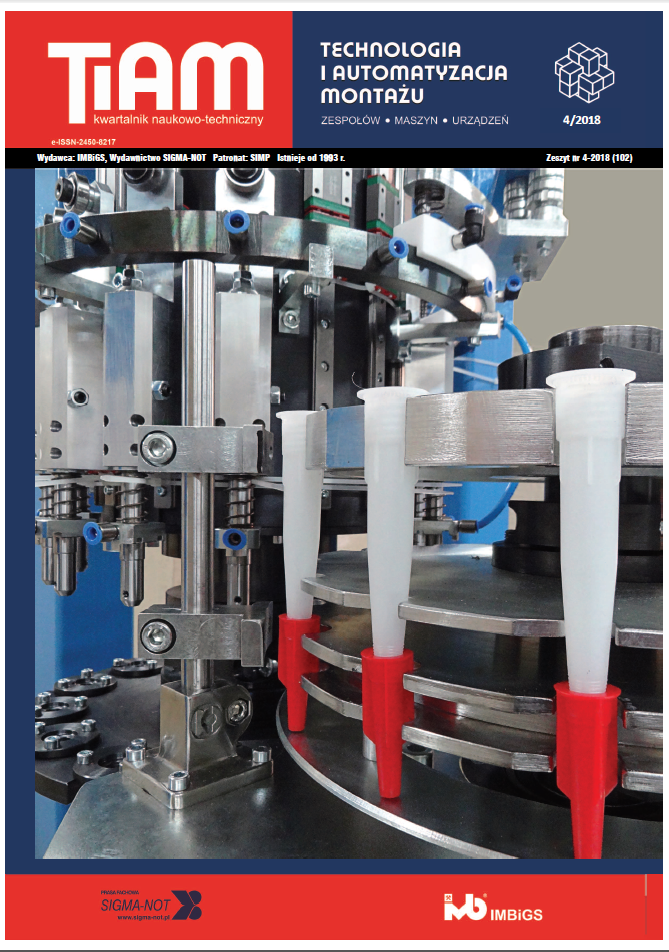Abstract
The paper presents the influence of the curing and seasoning conditions on the strength properties of the butt joints. The joined elements in the form of a two-stage roller are made of C45 alloy steel. These elements were bonded using the three types of the epoxy adhesive based on three various epoxy resins and PAC hardener: E5/PAC/100:80, E53/PAC/100:80, E571 PAC/100:80. The tests were carried out for three variants of the curing and seasoning period: 7 days of curing under ambient conditions, 7 days of curing and 7 days of seasoning in a climatic chamber, 3 days of curing and 7 days of seasoning in a climatic chamber. After the curing and seasoning period, peel strength of adhesive joints was determined in accordance with PN-59/C-89301. The highest strength from among the applied adhesive compositions was achieved by used E5/PAC/100:80 epoxy adhesive. Comparing the first variant of the seasoning time with the second, it was noticed that the seasoning of the samples for the next 7 days in the chamber negatively influenced their strength. However, the best results of peel strength were achieved for the third variant of the seasoning period. The presented variants of seasoning and their results diversity encourage further research to determine the technological factors affecting the best achievement of the assumed strength properties of adhesive joints.
This is an Open Access article distributed under the terms of the Creative Commons Attribution License CC BY 4.0 (https://creativecommons.org/licenses/by/4.0/)
References
Brockmann W. et. al. 2009. "Adhesive Bonding". Materials, Applications and Technology. Wiley-VCH, Weiheim.
Fink J.K. 2005. "Epoxy resin. Chapter 3 in: Reactive Polymers Fundamentals and Applications". A volume in Plastics Design Library.
Godzimirski J. i in. 1997. .Konstrukcyjne polaczenia klejowe elementów metalowych w budowie maszyn". Oficyna Wydawnicza Politechniki Rzeszowskiej.
Godzimirski J., A. Komorek, M. Roskowicz. 2008. "Trwałość zmęczeniowa tworzywa Epidian 57". Polimery (10): 737-742.
Godzimirski J., M. Rośkowicz, 2002. "Wytrzymałość doraźna i długotrwała oraz pełzanie kleju Epidian 57". Polimery (10): 721-726.
Kuczmaszewski J. 1990. .Technologia śmigłowców. Teoria i technika klejenia". Wydawnictwo Uczelniane Politechniki Lubelskiej.
Lapique F., K. Redford. 2013. "Curing effects on vi-scosity and mechanical properties of a commercial epoxy resin adhesive". International Journal of Adhe-sion and Adhesives (27): 1933-1950.
PN-59/C-89301 Kleje do metali. Oznaczanie wytrzymałości na odrywanie.
Rudawska A. 2013. "Wybrane zagadnienia konstytuowania połączeń adhezyjnych jednorodnych i hybrydowych". Wydawnictwo Uczelniane Politechniki Lubelskiej.
Rudawska A. i in. 2016. "Wytrzymałość połączeń klejowych po rożnym czasie sezonowania". Przetwórstwo Tworzyw(3): 126-131.
Rudawska A. 2016. "Wpływ wybranych czynników technologicznych i eksploatacyjnych na wytrzymałość polaczeń klejowych blach tytanowych". Techno-logia i Automatyzacja Montażu (3): 45-48.
Murakami S. et. al. 2016. "Strength of cylindrical butt joints bonded with epoxy adhesives under combined static or high-rate loading". International Journal of Adhesion and Adhesives (67): 86-93.
Pethrick R. A. 2015. "Design and ageing of adhesi¬ves for structural adhesive bonding-a review. Pro-ceedings of the Institution of Mechanical Engineers, Part L". Journal of Materials: design and applications (5): 349-379.
Spaggiari A., D. Castagnetti., E. Dragoni. 2012. "Experimental tests on tubular bonded butt specimens: effect of relief grooves on tensile strength of the adhesive". The Journal of Adhesion (88): 499--512.

